Original Title: "KOGE, ZKJ Nets Closed Overnight, Binance Alpha Forced to Grow"
Original Author: Wenser, Odaily Planet Daily
After a night passed, many Binance Alpha players found that "the sky has fallen" — the two major tokens KOGE and ZKJ, which have always been used for Alpha point interactions, experienced a flash crash. As of the time of writing, the price of ZKJ was reported at $0.32, with a 24-hour drop of up to 83.7%, previously reaching a 24-hour high of $1.98 and a low of $0.25; KOGE was reported at $27.75, with a 24-hour drop of 55.78%, previously reaching a 24-hour high of $62.81 and a low of $8.48.
In the latest news, Binance officially announced that it "has noticed significant price fluctuations in ZKJ and KOGE recently. Preliminary investigations show that this is mainly due to large holders withdrawing on-chain liquidity and market chain liquidations. Starting from June 17, 2025, at 00:00 (UTC), the Alpha point calculation rules will be adjusted, and the trading volume between Alpha tokens will no longer be included in the point calculation." The increasingly intense and dramatic "Binance Alpha exam" has finally reached a turning point due to the price flash crash of the ZKJ/KOGE trading pair. Odaily Planet Daily will sort out this event in this article and explore the pros and cons of the Binance Alpha mechanism and its possible future directions.
A Three-Week "Alpha Hunt": Using KOGE and ZKJ as Nets, Alpha Points as Bait
On May 24, as the BTC market gradually rose, the market's enthusiasm for Binance Alpha point interactions also surged, with trading volume once jumping to $1.69 billion, including $1.05 billion for ZKJ, $251 million for KOGE, and $205.9 million for B2, with the three leading the pack.
Due to the low trading friction costs of ZKJ and KOGE tokens and ample liquidity, large transactions of tens of thousands of dollars could participate in Binance Alpha interactions. After effective testing by market traders, the two major tokens became the best choices for "Alpha candidates," with KOGE's single transaction friction being controlled at around $0.5 for nearly $10,000. Many users in the community reported that KOGE might be a model of "one fish eating multiple meals" for large holders in the BSC ecosystem.
Originally, this was a "win-win" game:
- Binance Alpha gained users and transaction fees;
- BSC node large holders earned transaction fees;
- Binance Alpha users earned Alpha points;
- Project parties like KOGE and ZKJ collected LP fees and other returns.
However, once the balance of interests began to tilt, the seemingly balanced situation would instantly collapse, and the hard-won "harvest phase" would turn into a "net closing action." On June 14, the ZKJ and KOGE tokens experienced the "first downward test" before the storm — according to on-chain analyst AI Yi's monitoring, the usually stable ZKJ and KOGE both experienced a short-term drop of 3% between 21:20 and 22:05 that night, suspected to be due to address 0x364 withdrawing liquidity and continuous selling behavior.
This address withdrew 1.29 million ZKJ and 8,667 KOGE from OKX at 21:49, and subsequently:
- Sold approximately $3.1 million worth of ZKJ cumulatively at two points in time, 21:21 and 22:05; sold about $550,000 worth of KOGE at 21:20.
- ZKJ's trading volume surged to $12.73 million at 21:21, triggering a continuous decline within 15 minutes, possibly due to LP panic exits causing a chain reaction; a similar situation occurred at 22:05.
- KOGE, being closely tied to ZKJ, also suffered despite the small amount sold.
On June 15, ZKJ and KOGE faced the final net closing — three major addresses applied dual pressure through "large liquidity withdrawals + continuous selling," causing ZKJ and KOGE to collapse in sequence:
Between 20:28:58 and 20:36:57, 45,470 KOGE were exchanged for ZKJ, worth $3.796 million, during which KOGE's on-chain transaction volume showed a significant increase; between 20:30:57 and 20:59:49, 1.573 million ZKJ were sold in batches for USDT and BNB, worth $3.052 million, with an average selling price of $1.94. At this time, both KOGE and ZKJ experienced slight stepwise declines but did not crash.
Address 0x078 withdrew 33,651 KOGE (about $2.07 million) and 709,203 ZKJ (about $1.38 million) of bilateral liquidity at 20:30:33; between 20:31:10 and 20:58:18, exchanged 36,814 KOGE for ZKJ, worth $2.26 million; between 20:35:15 and 20:37:34, sold 1 million ZKJ, worth $1.948 million, with an average selling price of $1.948. The "relay-style dumping" from this address finally pushed KOGE's price into a free fall, reflected in the K-line as several consecutive large red candlesticks.
Address 0x6aD received 772,759 ZKJ, worth $1.5 million, transferred from address 0x078 (the second dumping address) at 20:41:55; between 20:42:28 and 20:50:16, cleared 772,000 ZKJ. It is evident that the third address was mainly used for coordination, further catalyzing ZKJ's decline after KOGE's price crash, completing the harvesting of both tokens' LPs and holders.
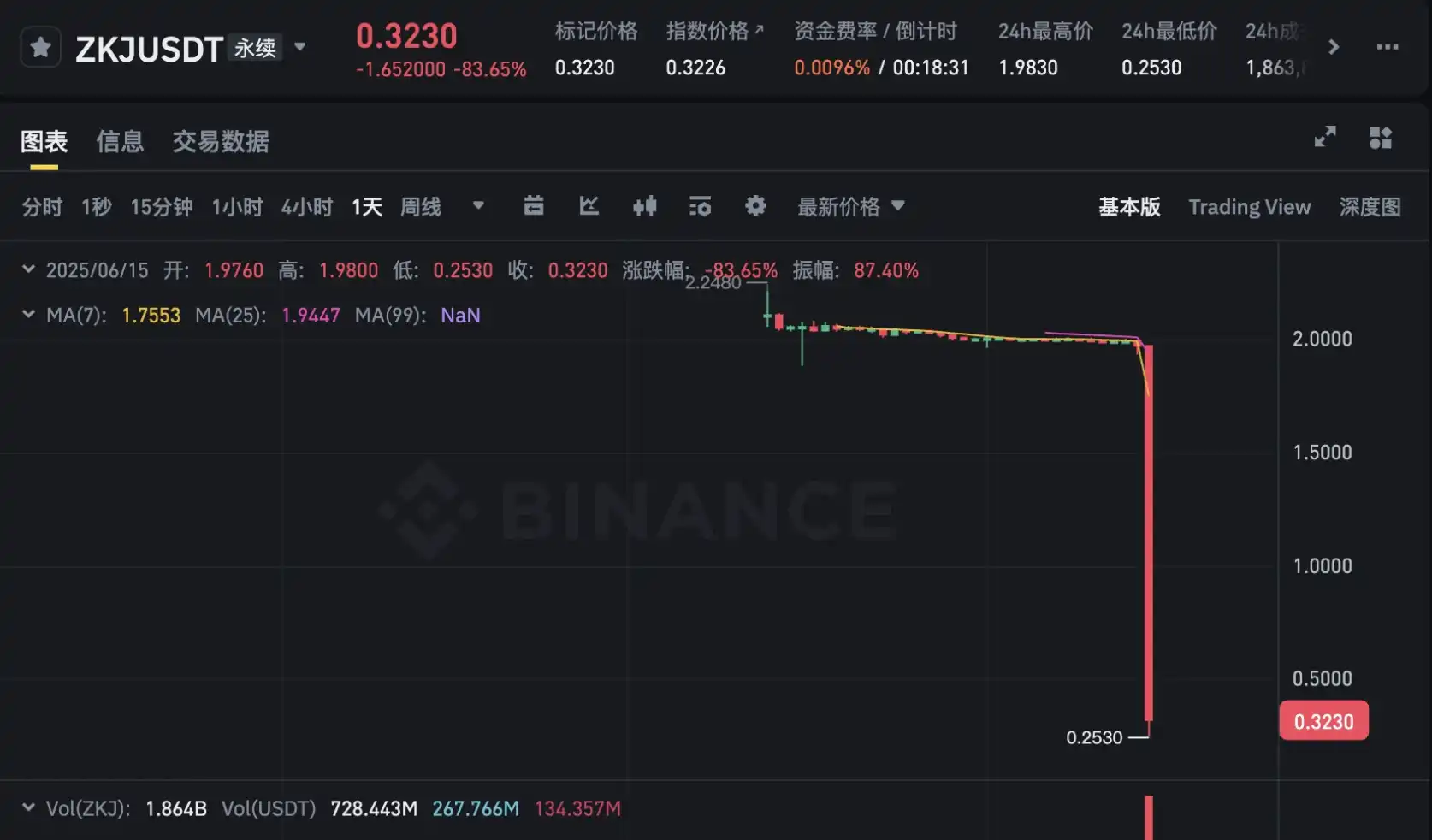
ZKJ K-line chart
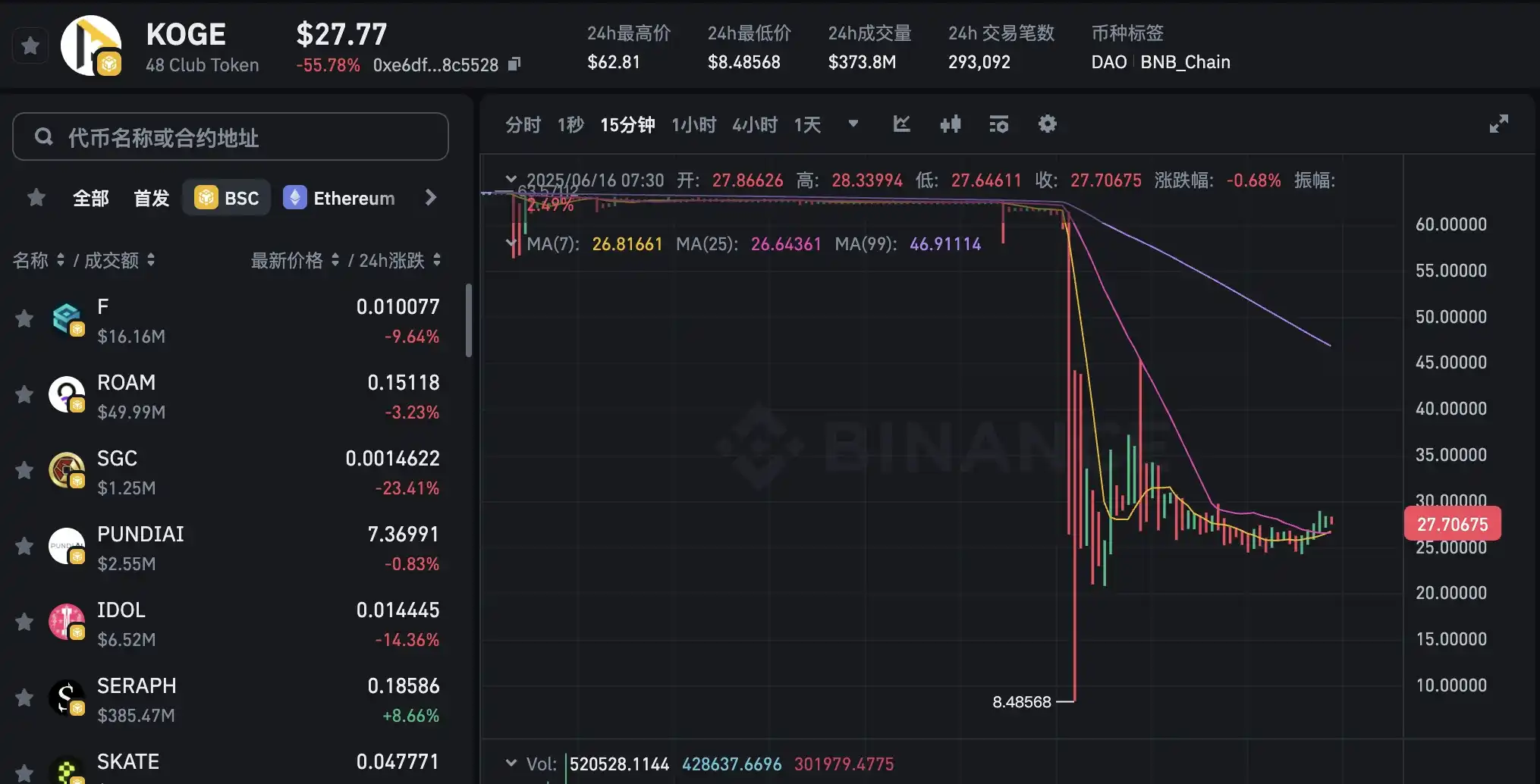
KOGE K-line chart
As for why the net closing action started with ZKJ, on-chain analyst AI Yi analyzed that it may be because ZKJ has CEX contracts, allowing the behind-the-scenes players to short on the trading platform while dumping on-chain; additionally, from a liquidity perspective, ZKJ has better liquidity, requiring more funds to execute the dump; furthermore, the LP ranges for ZKJ and KOGE are very narrow, and once this range is breached without enough funds to absorb sell orders, a flash crash is inevitable. Moreover, LPs seeing the price drop may panic and exit, creating a vicious cycle that further drives the price down; it is speculated that the continuous decline in Alpha trading volume over several days may have been a trigger, with the massive LP exit being a "run fast" game.
Additionally, according to crypto KOL Da Orange's reminder, the price of ZKJ tokens on the BSC chain is double that of tokens on the ETH chain, and the Binance ZKJ contract is for ETH chain tokens. The ZKJ tokens on the BSC chain in Binance Alpha are actually standalone tokens, meaning that the initial LP on BSC was provided by the team's own tokens. The first wave of dumping targeted the BSC tokens, followed by someone dumping on Bybit, causing the contract to crash, and then the spot price on the ETH chain also collapsed.
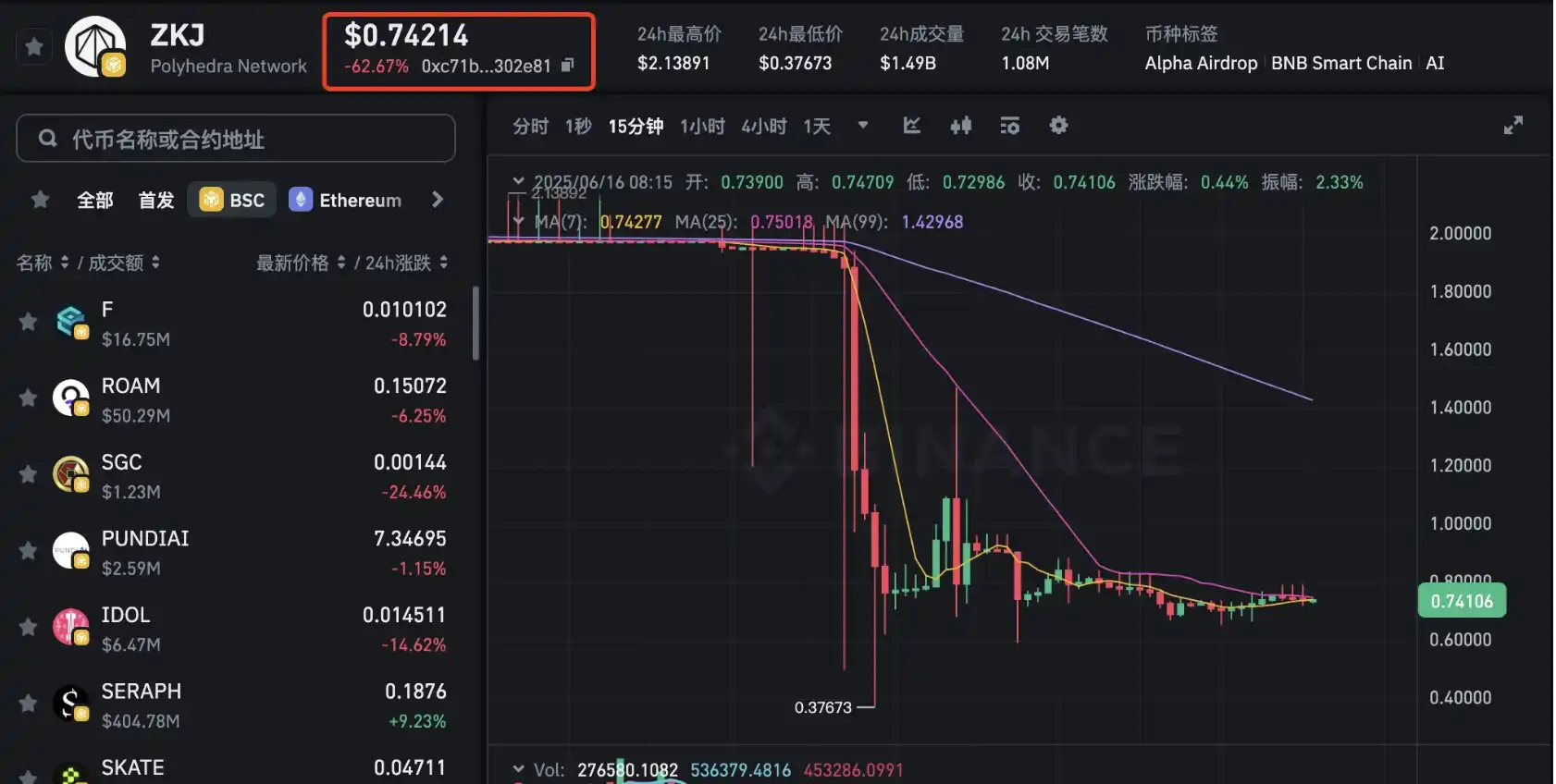
Price of ZKJ tokens on the BSC chain in Binance Alpha
According to Coinglass data, the total liquidation amount across the network in the past 24 hours was $215 million, with long positions accounting for $157 million of the liquidations, and the liquidation amount for ZKJ alone reached $102 million. For KOGE large holders who completed liquidity exits using KOGE/ZKJ, it was a bloody liquidity feast.
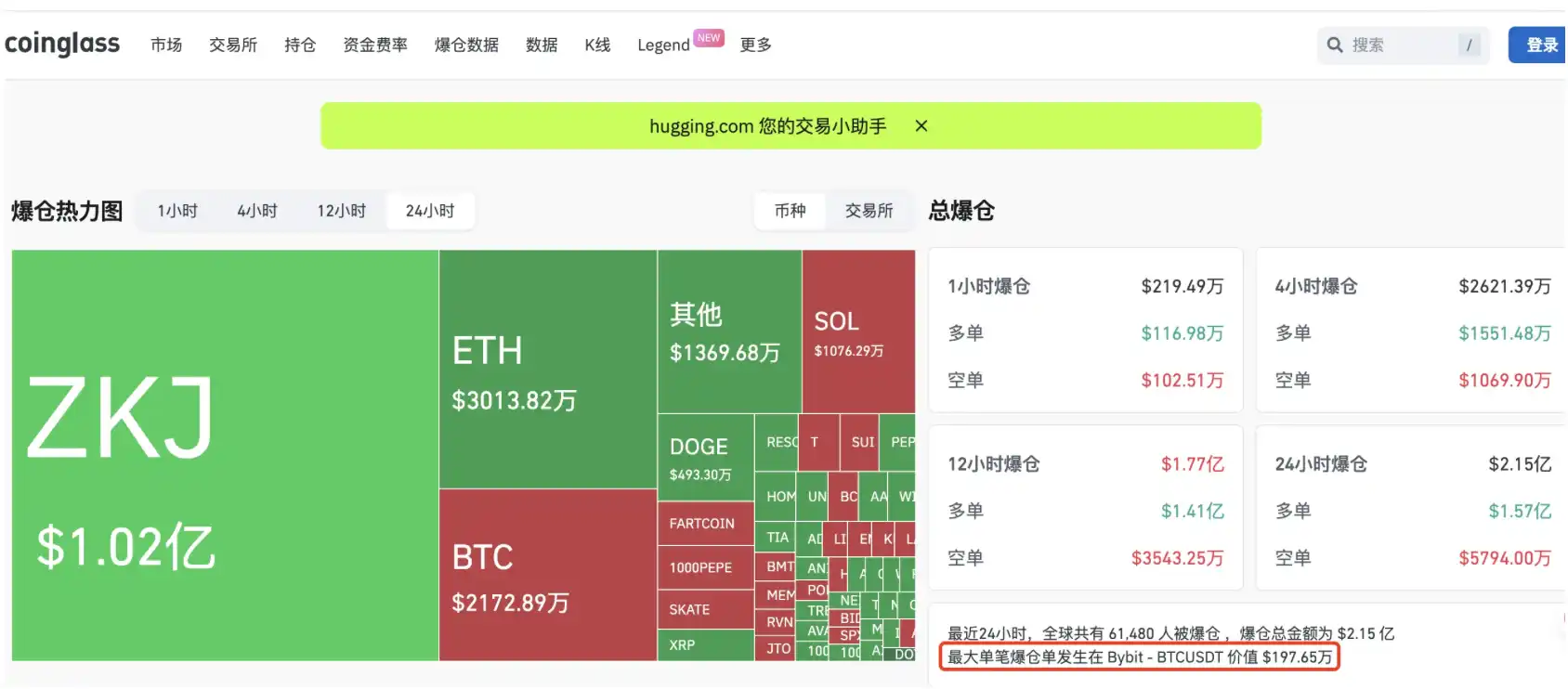
The largest single token liquidation occurred on Bybit
In summary, the flash crash of ZKJ and KOGE was a premeditated hunting operation, and Binance Alpha points were a seemingly appetizing yet dangerous bait.
Traders Trapped in the Fortress of Binance Alpha: Points Like Exam Scores, Airdrops as Gifts and Costs
After experiencing the flash crash of ZKJ and KOGE, discussions about the Binance Alpha point system have become heated, with many people only reaping the bitter fruit of "assets down over 80%" from this incident, leading to considerable grievances against the Binance Alpha mechanism. The Binance official's immediate announcement also indicated the seriousness of this event.
Binance Alpha Airdrops Cannot Offset ZKJ Flash Crash Losses
As on-chain analyst AI Yi stated, the total value of all project airdrops from Binance Alpha to date does not exceed the market value lost by ZKJ. Its market value once plummeted from $2 billion to $377 million, evaporating about 81% of its market value in less than a day. This highlights the high volatility and brutality of the cryptocurrency industry. Many people invested thousands or even tens of thousands of dollars, and their assets shrank by over 80%.
Previously, according to X platform user Mingo Mingge's statistics, Binance Alpha's earnings for May were about $1,500. For many, after working hard for a month, this wave of net closing resulted in losses of thousands or even tens of thousands of dollars, which can be described as not worth the effort.
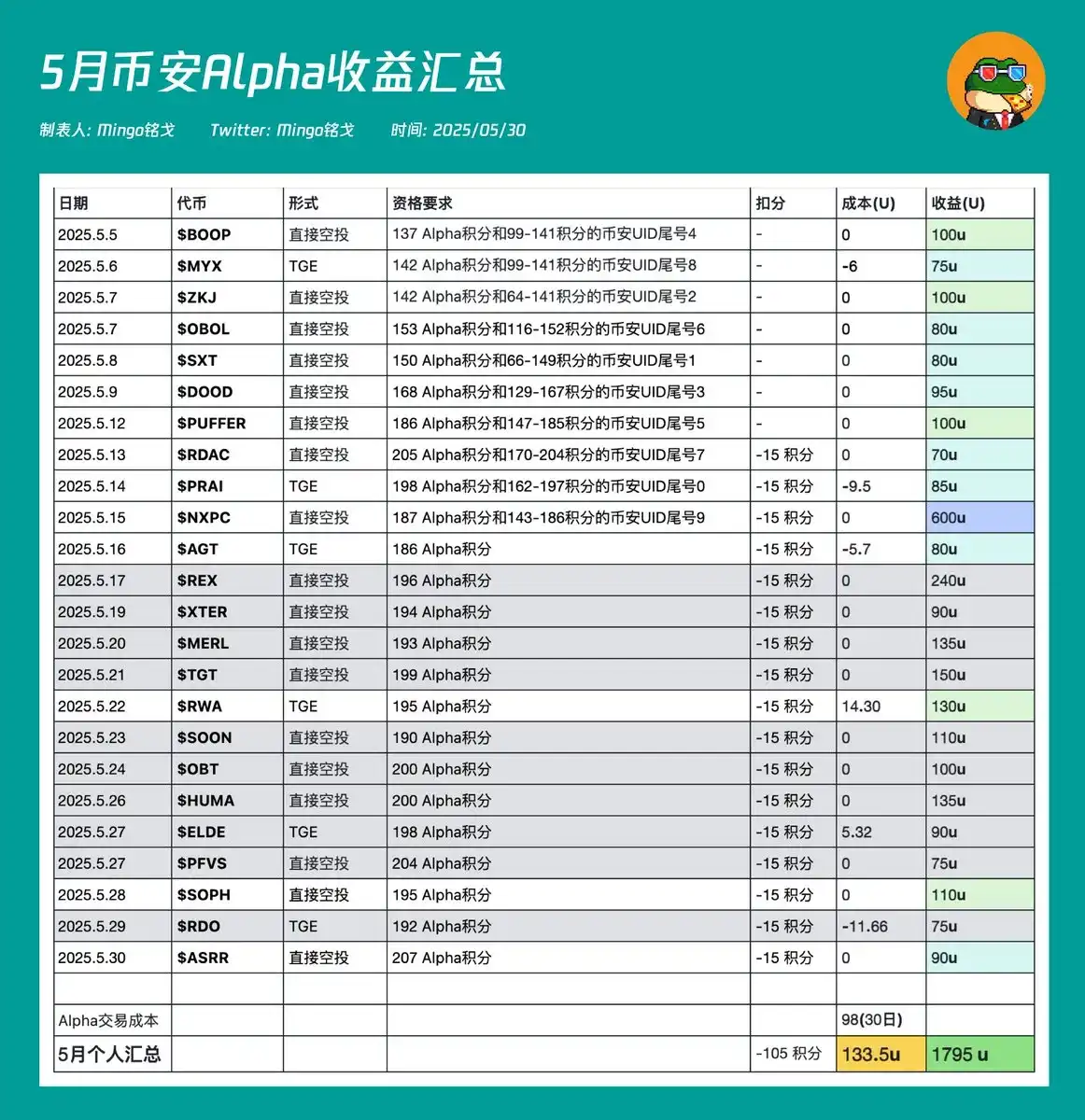
Overview of Binance Alpha's earnings in May
Binance Alpha Points Become a Digital Game, Need to Change Thinking
After the turmoil, Binance officially released a statement, indicating: "We have noticed significant price fluctuations in ZKJ and KOGE recently. Preliminary investigations show that this is mainly due to large holders withdrawing on-chain liquidity and market chain liquidations. To maintain market fairness and stability, and to reduce systemic risks brought by centralization, Binance will adjust the Alpha point calculation rules starting from June 17, 2025, at 00:00 (UTC). At that time, the trading volume between Alpha tokens will no longer be included in the point calculation."
Moving forward, Binance Alpha may need to change its purely digital game style. Specifically, the following ideas could be considered:
Avoid mechanisms that concentrate trading volume on a few tokens like KOGE and ZKJ, ensuring that interaction friction is relatively average and controllable;
Increase the sources of Alpha points, not just limited to token trading. For example, community dissemination, posting on Binance Square, and other InfoFi-oriented "mouth-to-mouth" methods could also be considered as ways to interact with Alpha points;
Establish a monitoring mechanism to prevent situations where large KOGE holders manipulate the series of chains such as "token issuance - liquidity pool creation - Alpha token listing - Alpha point acquisition" from happening again. Of course, this point is highly idealized and extremely difficult.
KOGE Project Party Strongly Responds: Has Nothing to Do with Me, Never Held ZKJ, Let Alone Dumped KOGE
In response to the flash crash of KOGE and ZKJ prices last night, Ian, the founder of the KOGE project party 48 Club, posted on Binance Square this morning, stating: "The crash was not due to the 48 Club treasury dumping KOGE, nor was it due to my personal dumping of KOGE; the 48 Club has no business dealings with the ZKJ project party, nor any similar plans; the 48 Club treasury has never held (or held) ZKJ; I have never held (or held) ZKJ. Binance Research and Binance Web3 have had colleagues consult me about the price drop event, and I have provided the above explanation. The 48 Club has never offered a 'low-fee pool that restricts large amounts from entering'; in fact, it is technically impossible to do so by providing IP."
As a super node in the BSC ecosystem, Ian's response seems more like an excuse to clear himself of any connection to the matter. However, based on the existing information, it is indeed impossible to prove a direct link to the dumping addresses, and the truth of the event still awaits further investigation.
Summary: The Liquidity Feast Ultimately Paid for by Retail Investors
In the end, the most hurt are still the retail investors in the market. After all, Binance, as a platform, still reaped transaction fees and other returns, while large holders of ZKJ and KOGE completed their liquidity harvesting, and retail investors became a batch after batch of "leeks" being harvested. But for the "sickles," if such a rapid and frequent harvesting continues, who will be there to keep buying?
免责声明:本文章仅代表作者个人观点,不代表本平台的立场和观点。本文章仅供信息分享,不构成对任何人的任何投资建议。用户与作者之间的任何争议,与本平台无关。如网页中刊载的文章或图片涉及侵权,请提供相关的权利证明和身份证明发送邮件到support@aicoin.com,本平台相关工作人员将会进行核查。



